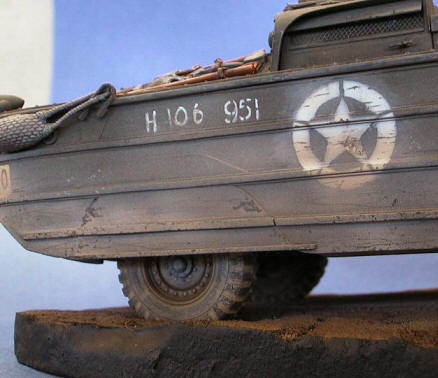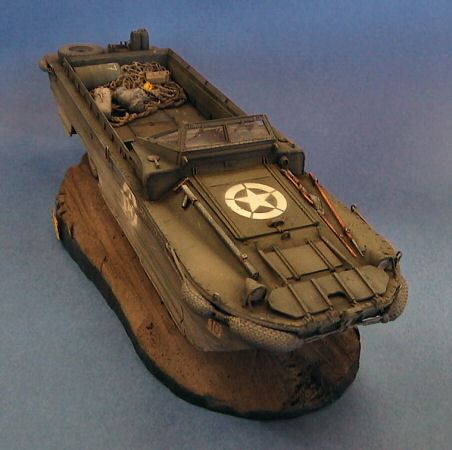Italeri 1/35 DUKW
by Bengt Johansson
One thing you couldn’t say about it is that it was pretty. All other virtues were built-in! DUKW was a 2.5-ton, six-wheel amphibious born out of the need to support amphibious operations in World War II. Its primary use was to ferry ammunition, supplies, and equipment from supply ships in transport areas offshore to supply dumps and fighting units at the beach. It was first used in ”Operation Husky,” the invasion of Sicily in 1943. A whopping total of 18,000 trucks was used by the US Army and Marine Corps, i addition to 2,000 vehicles supplied to the British.
The acronym-loving military officials designated it DUKW (D-model year 1942, U-amphibian, K-all wheel drive, W-dual rear axles), but everyone else just called it ”duck”.
In the Normandy Invasion of 1944, DUKWs played a vital role in the overall success of the landing, but also suffered large losses due to high seas during the crucial first days of the operation. For example, at Omaha Beach, the 1st Infantry Division attempted to deploy its 105-millimetre howitzers, gun crews, ammunition, and sand bags in DUKWs; all but one of the 13 DUKWs of the 111th Field Artillery Battalion sank.
Italeri DUKW
Until Italeri released a 1/35 DUKW kit in 202, there was really no proper scale kit of this very important vehicle. Bengt Johansson is the author of this model, and the description contained below based on his comments on the kit’s construction.
To break from the usual ”construction start with the xxx” (fill you favourite part) style of description, We’ll rather walk through the model and list the modifications made to a particular area.
Hull
Fine as it was, the Italeri kit had visible ejector pin marks on the ribs of the hull, these were filled in and sanded smooth. At the beginning of the construction, the hollow wheel wells were also properly furnished with plasticard.
Bengt opted for new rivets for the model. These were most prominent along the edge of the top decking where it joined the hull, but there were many of them in other places, too. Altogether the model carries over 250 replacement rivets.
Cooling air intakes in front of the of the windscreen were detailed with wire mesh, and exhhaust pipes replaced with scratchbuilt items.
Bow
Compared with the kit, Bengt added a couple of new details. The headlight guards were scratchbuilt. Signal horn was made from a couple of scrap bits including an ink pen reservoir. The tools came from Academy ”spares”. Holding straps were made from metal foil with buckles added from fine copper wire.
Driver’s compartment
The plumbing of the pneumatic drive for the windscreen wipers was added together with a few more scratchbuilt accessories: med kit at the back of the driver’s seat and fasteners for a machine gun (visible behind the passenger’s seat). A personal GI sack and a fire extinguisher added a final touch to this area.
Cargo comparment
Compared with what was offered in the Italeri kit, there wasn’t much more detail that could be added to this area. The only modification to was the addition of tarpaulin tie-down hooks along the outer rim of the compartment.
The looks of a hollow cargo area like this can be grossly improved by a realistically worn finish. How this was done can be judged from the pictures. A group of accessories ”thrown” in the rear not only adds more life to the area, but also emphasizes the purpose of the DUKW, making the model self-explanatory even to the uninitiated viewer. The cargo net came from Tracks & Boots. The ropes are actually treads pulled from a carpet. The Shell jerrycan came from Pluss Models, and the remaining drum plus bags from Tamiya.
Stern
At the rear, details like light guards, variuos fasteners, mounts for the crane and hooks for the were all scratchbuilt. The helmet visible as an additional bumper (TODO: wording?) is another Tamiya accessory item.
This article was originally published in IPMS Stockholms Magazine in November 2004.








